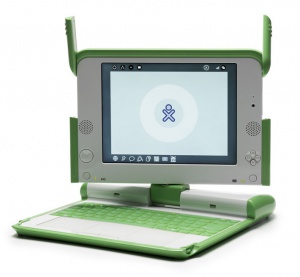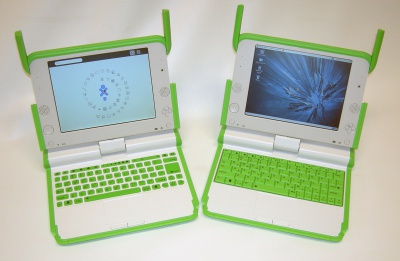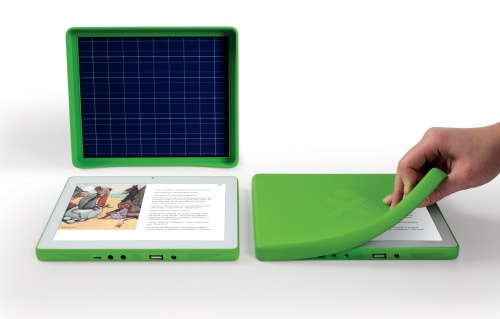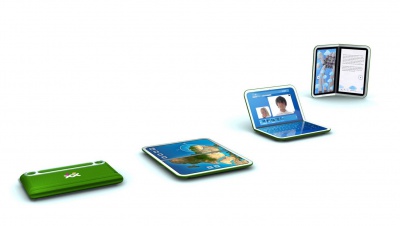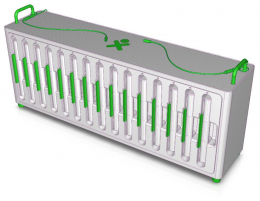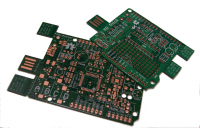Hardware: Difference between revisions
(no width yet) |
mNo edit summary |
||
| (121 intermediate revisions by 35 users not shown) | |||
| Line 1: | Line 1: | ||
{{ |
{{OLPC}} |
||
One Laptop per Child believes that innovative design is capable of bringing robust computing to children in the developing world at low power and low cost. |
|||
'''''[[Hardware specification]] is the main article'''''. |
|||
:'' '''Note:''' this page needs significant [[:category:cleanup|cleanup]]'' |
|||
Unlike traditional computer manufacturers, the design goals of OLPC are (in order): |
|||
[[Image:ebookdrawing75c.png|thumb|right|EBook Configuration]] |
|||
# Safe -- no children should be harmed |
|||
# Lowest Power -- low power means longer run-time |
|||
# Lowest Cost -- a lower cost means more children can have one |
|||
# Robust and Maintainable -- children drop things |
|||
# Performance (speed) |
|||
The XO Laptop features a revolutionary hardware design, combining power with power eficiency, at an unprecedentedly low cost. |
|||
==Laptops== |
|||
Image:drawing75c.jpg|Labelled XO picture |
|||
===XO Laptop=== |
|||
poly 131 45 213 41 210 110 127 109 Antenna |
|||
poly 131 45 213 41 210 110 127 109 Display |
|||
poly 104 126 105 171 269 162 267 124 Keyboard |
|||
circle 57 57 20 Camera |
|||
# Comment : rect takes two corners. |
|||
desc bottom-right |
|||
The XO Laptop ([[NL3]]) is a high performance low cost laptop with 16:9 display. |
|||
[[Image:bottomdrawing.jpg|thumb|right|Bottom View]] |
|||
[[Image:B1-mikemcgregor-2-small.jpg|300px|right]] |
|||
The picture on the right locates most of the features of the machine. To open the machine you must first unlatch the antennae and then lift it open. |
|||
The XO-1, XO-1.5, XO-1.75 and XO-4 laptops were the most rugged low power, low cost laptop available; |
|||
To rotate the screen to transform to ebook mode, the screen must be in the 90% upright position. It can only rotate one of two directions to the point where the screen can again be closed down over the keyboard. |
|||
* [[XO|The Children's Laptop]] |
|||
* [[Hardware_uniqueness|Why it is unique]] |
|||
* [[Keyboard]] |
|||
* [[Display]] |
|||
* [[Laptop_Batteries|Batteries]] ([[Battery Charging]]) |
|||
* [[Hardware_Testing|Certifications (Safety and RF emissions)]] |
|||
* [[Environmental Impact]] ([[Green_Machine|The Green Machine]]) |
|||
* [[Hardware_modification|User modifications of the laptop]] |
|||
===XO-4 Touch=== |
|||
The battery pack is located under the screen underneath the keyboard, and is released by two slide latches as seen in the lower thumbnail. You can also see the SD slot clearly. Note: the plastic will be textured in later builds so the surface of the machine will not be shiny. |
|||
2013: The XO-4 Touch is the latest refresh of the XO laptop. It is available in two models: XO-4 and XO-4 Touch, with the latter providing multi-touch input on the display. Like the XO-1.75, it uses an ARM processor to provide high performance with low power consumption, while keeping the industrial design and batteries of the XO-1. |
|||
== Display == |
|||
:''See [[Display]] for more details.'' |
|||
* more detail: [[XO-4_Touch|XO-4 Touch]], |
|||
The XO's dual-mode display is much cheaper than traditional laptop displays, and uses much less power. It functions both in a full-color transmissive mode similar to any other LCD, but can also be used in an ultra-low-power black-and-white reflective mode, readable in direct sunlight. |
|||
* [[Media:CL4_Hdwe_Design_Spec.pdf|definitive hardware specification]] (PDF), |
|||
* production models: [[XO_4_C2|C2]], |
|||
* pre-production prototypes: [[XO_4_C1|C1]], [[XO_4_B1|B1]], [[XO_4_A2|A2]], [[XO_4_A1|A1]]. |
|||
== |
===XO-1.75 Laptop=== |
||
:''See [[Wireless]] for more details.'' |
|||
2010: OLPC started development of a laptop based around an ARM processor, in order to finally reach an operating power low enough to allow a full day of operation from a single battery charge, as well as better operation from solar and human energy sources. This refresh continues to use the same industrial design, display, and batteries as XO-1. |
|||
The XO's wireless chip works over a longer range than the wireless cards in most laptops. It is compatible with 802.11b/g, and its mesh networking is based on the draft 802.11s standard. |
|||
[[Image:XO-1.75_siblings.jpg|400px|center]] |
|||
* more detail: [[XO-1.75]], |
|||
== Durability == |
|||
* [[Media:CL2_Hdwe_Design_Spec.pdf|definitive hardware specification]] (PDF), |
|||
:''See [[Durability]] for more details.'' |
|||
* production models: [[XO_1.75_C2|C2]] (as of 2013), |
|||
* pre-production prototypes: [[XO_1.75_C1|C1]], [[XO_1.75_B1|B1]], [[XO_1.75_A3|A3]], [[XO_1.75_A2|A2]], [[XO_1.75_A1|A1]]. |
|||
===XO-1.5 Laptop=== |
|||
The XO is far more durable than conventional laptops. It has no moving parts, eschewing a hard drive for flash memory, and using as few internal connectors as possible. |
|||
2009: A refresh of the XO-1 laptop happened. In a continued effort to maintain a low price point, OLPC refreshed the laptop electronics to use the latest component technologies. This refresh (Gen 1.5) is separate from the Gen 2/3 projects, and continue to use the same industrial design and batteries as Gen 1. This provides an overall update of the system within the same ID and external appearance, giving school systems using the XO-1 with a cost effective replacement. |
|||
== Power usage == |
|||
:''See [[Battery and power]] and [[Power Management]] for more details.'' |
|||
* more detail: [[Hardware specification 1.5|XO-1.5]], |
|||
The XO uses much less power than existing laptops, due to a combination of low-power components and aggressive power management. |
|||
* [[Media:XO1.5_Hardware_Design_Brief.pdf|hardware brief]] (PDF), |
|||
* [[Media:CL1B_Hdwe_Design_Spec.pdf|definitive hardware specification]] (PDF), |
|||
* [http://blog.laptop.org/2009/04/17/announcing-the-xo-15-updated-hardware-for-the-xo-laptop/ Announcement, April 17, 2009], |
|||
* no longer in production: [[XO_1.5_C5|CL1B C5]], [[XO_1.5_C3|CL1B C3]], [[XO_1.5_C2|CL1B C2]], |
|||
* pre-production prototypes: [[XO_1.5_C1|C1]], [[XO_1.5_B3|B3]], [[XO_1.5_B2|B2]], [[XO_1.5_B1|B1]], [[XO_1.5_A2|A2]], [[XO_1.5_A1|A1]]. |
|||
===XO-1 Laptop=== |
|||
== Input and output devices == |
|||
:''See [[Keyboard]], [[Touchpad]], [[Camera]], [[Audio]], [[USB]], [[SD]]'' for details |
|||
This was the original XO laptop, of which over a million were manufactured. Production of the XO-1 stopped in Spring 2010. |
|||
The XO laptop includes a child-sized keyboard, a new dual-use touchpad, a built-in video camera, stereo speakers and a microphone, three USB ports, and an SD card slot. |
|||
* more detail: [[Hardware_specifications|XO-1]], |
|||
== Cost == |
|||
* [[Media:CL1A_Hdwe_Design_Spec.pdf|definitive hardware specification]] (PDF), |
|||
* no longer in production: [[XO CL1A]], [[XO_C2|CL1]], |
|||
* pre-production prototypes: [[XO_C1|C1]], [[XO_B4|B4]], [[XO_B3|B3]], [[XO_B2|B2]], [[XO_B1|B1]], [[XO_A|A1]]. |
|||
==Ideas== |
|||
The XO laptop, with a target cost of $100/unit, is cheaper than any fully-featured laptop on the market. |
|||
While developing the XO, many [[Hardware_ideas|ideas for hardware]] were contributed. OLPC had several designs which saw some development, but never progressed further than sample production: the XO-3, the XS School server, the Multibattery Charger, and the Active Antenna. |
|||
===XO-3 Tablet=== |
|||
:''Main page: [[XO-3]]'' |
|||
From 2010 to 2012, OLPC worked on developing a low cost, low power, robust tablet for use by kids. A prototype was shown off at CES 2012, and the industrial design was further refined. Production was originally scheduled for the end of 2012. Cancellation of this project has now been [http://www.networkworld.com/news/2012/112912-olpc-cancels-xo-3-tablet-downplays-264647.html announced.] |
|||
<gallery> |
|||
Image:B1-mikemcgregor-1.jpg |
|||
Image:B1-mikemcgregor-2.jpg |
|||
Image:B1-mikemcgregor-3.jpg |
|||
Image:AP1_39.jpg |
|||
Image:AP1_31.jpg |
|||
Image:Proto-a-linux.jpg |
|||
Image:Board-mockup.jpg |
|||
Image:Proto-a-front.jpg |
|||
</gallery> |
|||
[[Image:XO-3_Photo10.jpg|500px|center]] |
|||
'''See [[Hardware specification]].''' |
|||
'''XO-3 Versions:''' ''Never entered production''; ''CL3 pre-production models are:'' [[XO_3_A1|A1]] |
|||
== See also == |
|||
===XO-2 Foldable Tablet=== |
|||
*[[Hardware specification]] |
|||
[[Image:XO2-modes.jpg|400px|center]] |
|||
*[[Hardware modification]] |
|||
*[[Talk:Hardware specification]] |
|||
In May of 2008, plans for the next generation of OLPC laptops were publicly announced. Nicholas Negroponte challenged the design team to aim for those goals while also rethinking the notion of a laptop. The result doesn't fit neatly into the "laptop" category. The form factor is that of a book or folded (clam shell) tablet --- a handbook. At this time, development of this device has been halted. |
|||
*[[:Category:Hardware]] |
|||
*[[Pictures]] |
|||
* [[XO-2|Additional details]] |
|||
<br clear="all"> |
|||
===XS School Server=== |
|||
[[Image:XS_floor_diag.png|100px|left]] |
|||
While the laptop is rightfully at the center of OLPC, a valuable peripheral is the [[School_server|school server]]. Recognizing this, OLPC designed a [[School server]] to extend the storage and computation provided by each laptop, as well as providing a local library and a mesh portal to the Internet. But this is more of a [[XS_Server_Services|collection of services]] than a hardware platform. Unlike the laptop, which has a well defined user load (one child), the [[School_server|school server]] is designed to serve an entire school, whose sizes vary greatly. Thus a variety of hardware solutions is necessary. Thankfully, an entire industry is available serving this hardware need, at a variety of price and power levels from small fanless systems to desktop PCs to large servers. For example, small and mid-sized schools should be well served by this [[XS_Recommended_Hardware|recommended hardware]]. |
|||
There is a persistent need for a low cost, robust server solution for environmentally extreme and low power situations (jungles/salt water). OLPC designed a low cost [[XS_Server_Specification#XS_Specifications|XS server]] (pictured) with sealed operation up to 50C. ''Unfortunately, it is still looking for a manufacturer.'' |
|||
<br clear="all"> |
|||
===Multichannel battery charger=== |
|||
[[Image:Multi-Battery_Charger.png|260px|right]] |
|||
Classroom situations, especially those without "grid" power, are challenging for powering laptops. One of the solutions is a multiple battery charger, which allows a number of laptop batteries to be charged in a small cabinet taking AC or 12VDC input. |
|||
OLPC has pursued the design of a [[Multi_channel_battery_charger|Multi-Battery Charger]] for the [[Hardware#XO_Laptop|XO Laptop]], and has units entering safety testing in Jan. 2008. |
|||
<br clear="all"> |
|||
===Active Antenna=== |
|||
[[Image:AA-tilted.jpg|100px|left]] |
|||
The [[Active Antenna]] is the same Marvell radio used in the XO-1 laptop, but on a 5m USB cable allowing their use either standalone (with a power supply) or with a [[School server]]. ''Unfortunately, Active Antenna production is awaiting the development of a better mesh implementation for dense mesh situations. We currently recommend the use of traditional 802.11b/g access points with the XO.'' |
|||
<br clear="all"> |
|||
==Extras== |
|||
The manufacture of the XO-4 Touch created an opportunity in the form of extra printed circuit board space that would otherwise have been scrap. That spare PCB area was used to create two different embedded development boards, both compatible with the popular [http://arduino.cc/en/ Arduino] family of open hardware. |
|||
[[Image:xostick_xorduino.png|200px|right]] |
|||
The [[XO Stick]] utilizes either of two very low-cost AVR microcontrollers, and can be easily assembled: the few components are all mounted through-hole, making the soldering easy. |
|||
The [[XOrduino]] uses a far more powerful AVR processor, but also requires the ability to solder surface-mount parts. |
|||
{{stub}} |
|||
[[Category:Hardware]] |
[[Category:Hardware]] |
||
[[Category:Developers]] |
|||
[[Category:XO]] |
|||
[[Category:XO-1.5]] |
|||
[[Category:XO-1.75]] |
|||
[[Category:XO-2]] |
|||
[[Category:XO-3]] |
|||
[[Category:XO-4]] |
|||
Latest revision as of 05:25, 23 August 2016
One Laptop per Child believes that innovative design is capable of bringing robust computing to children in the developing world at low power and low cost.
Unlike traditional computer manufacturers, the design goals of OLPC are (in order):
- Safe -- no children should be harmed
- Lowest Power -- low power means longer run-time
- Lowest Cost -- a lower cost means more children can have one
- Robust and Maintainable -- children drop things
- Performance (speed)
Laptops
XO Laptop
The XO Laptop (NL3) is a high performance low cost laptop with 16:9 display.
The XO-1, XO-1.5, XO-1.75 and XO-4 laptops were the most rugged low power, low cost laptop available;
- The Children's Laptop
- Why it is unique
- Keyboard
- Display
- Batteries (Battery Charging)
- Certifications (Safety and RF emissions)
- Environmental Impact (The Green Machine)
- User modifications of the laptop
XO-4 Touch
2013: The XO-4 Touch is the latest refresh of the XO laptop. It is available in two models: XO-4 and XO-4 Touch, with the latter providing multi-touch input on the display. Like the XO-1.75, it uses an ARM processor to provide high performance with low power consumption, while keeping the industrial design and batteries of the XO-1.
- more detail: XO-4 Touch,
- definitive hardware specification (PDF),
- production models: C2,
- pre-production prototypes: C1, B1, A2, A1.
XO-1.75 Laptop
2010: OLPC started development of a laptop based around an ARM processor, in order to finally reach an operating power low enough to allow a full day of operation from a single battery charge, as well as better operation from solar and human energy sources. This refresh continues to use the same industrial design, display, and batteries as XO-1.
- more detail: XO-1.75,
- definitive hardware specification (PDF),
- production models: C2 (as of 2013),
- pre-production prototypes: C1, B1, A3, A2, A1.
XO-1.5 Laptop
2009: A refresh of the XO-1 laptop happened. In a continued effort to maintain a low price point, OLPC refreshed the laptop electronics to use the latest component technologies. This refresh (Gen 1.5) is separate from the Gen 2/3 projects, and continue to use the same industrial design and batteries as Gen 1. This provides an overall update of the system within the same ID and external appearance, giving school systems using the XO-1 with a cost effective replacement.
- more detail: XO-1.5,
- hardware brief (PDF),
- definitive hardware specification (PDF),
- Announcement, April 17, 2009,
- no longer in production: CL1B C5, CL1B C3, CL1B C2,
- pre-production prototypes: C1, B3, B2, B1, A2, A1.
XO-1 Laptop
This was the original XO laptop, of which over a million were manufactured. Production of the XO-1 stopped in Spring 2010.
- more detail: XO-1,
- definitive hardware specification (PDF),
- no longer in production: XO CL1A, CL1,
- pre-production prototypes: C1, B4, B3, B2, B1, A1.
Ideas
While developing the XO, many ideas for hardware were contributed. OLPC had several designs which saw some development, but never progressed further than sample production: the XO-3, the XS School server, the Multibattery Charger, and the Active Antenna.
XO-3 Tablet
- Main page: XO-3
From 2010 to 2012, OLPC worked on developing a low cost, low power, robust tablet for use by kids. A prototype was shown off at CES 2012, and the industrial design was further refined. Production was originally scheduled for the end of 2012. Cancellation of this project has now been announced.
XO-3 Versions: Never entered production; CL3 pre-production models are: A1
XO-2 Foldable Tablet
In May of 2008, plans for the next generation of OLPC laptops were publicly announced. Nicholas Negroponte challenged the design team to aim for those goals while also rethinking the notion of a laptop. The result doesn't fit neatly into the "laptop" category. The form factor is that of a book or folded (clam shell) tablet --- a handbook. At this time, development of this device has been halted.
XS School Server
While the laptop is rightfully at the center of OLPC, a valuable peripheral is the school server. Recognizing this, OLPC designed a School server to extend the storage and computation provided by each laptop, as well as providing a local library and a mesh portal to the Internet. But this is more of a collection of services than a hardware platform. Unlike the laptop, which has a well defined user load (one child), the school server is designed to serve an entire school, whose sizes vary greatly. Thus a variety of hardware solutions is necessary. Thankfully, an entire industry is available serving this hardware need, at a variety of price and power levels from small fanless systems to desktop PCs to large servers. For example, small and mid-sized schools should be well served by this recommended hardware.
There is a persistent need for a low cost, robust server solution for environmentally extreme and low power situations (jungles/salt water). OLPC designed a low cost XS server (pictured) with sealed operation up to 50C. Unfortunately, it is still looking for a manufacturer.
Multichannel battery charger
Classroom situations, especially those without "grid" power, are challenging for powering laptops. One of the solutions is a multiple battery charger, which allows a number of laptop batteries to be charged in a small cabinet taking AC or 12VDC input.
OLPC has pursued the design of a Multi-Battery Charger for the XO Laptop, and has units entering safety testing in Jan. 2008.
Active Antenna
The Active Antenna is the same Marvell radio used in the XO-1 laptop, but on a 5m USB cable allowing their use either standalone (with a power supply) or with a School server. Unfortunately, Active Antenna production is awaiting the development of a better mesh implementation for dense mesh situations. We currently recommend the use of traditional 802.11b/g access points with the XO.
Extras
The manufacture of the XO-4 Touch created an opportunity in the form of extra printed circuit board space that would otherwise have been scrap. That spare PCB area was used to create two different embedded development boards, both compatible with the popular Arduino family of open hardware.
The XO Stick utilizes either of two very low-cost AVR microcontrollers, and can be easily assembled: the few components are all mounted through-hole, making the soldering easy.
The XOrduino uses a far more powerful AVR processor, but also requires the ability to solder surface-mount parts.
